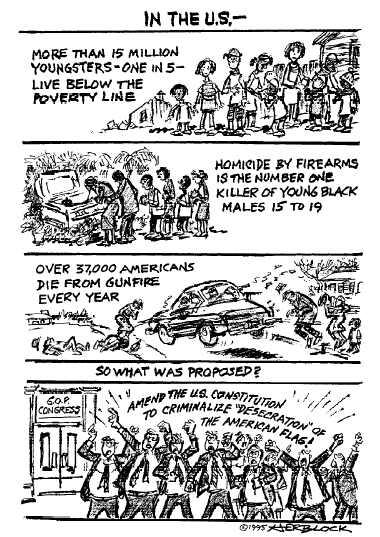‘One Country! One Language! One Flag!’
Illustrator: Herblock / Creator's Syndicate

I can remember my high school geometry teacher, Mr. Glandon, leading the class in the Pledge of Allegiance every morning. He ordered us to stand at attention, hands over our hearts. Anyone who was less than enthusiastic was branded an “opposition maker” — one of his favorite terms — and awarded demerits. This was in Northern California in 1968, at the height of the Vietnam War, grow-ing militancy of groups like the Black Panthers, and not long after the San Fran-cisco counter-culture’s “Summer of Love”. For Mr. Glandon, forcing us to recite the Pledge was his small contribution in the war to preserve one version of America.
HISTORY OF PLEDGE
The Pledge has always been political. It was written in 1892 by Francis Bellamy, and published in the national magazine The Youth’s Companion to com-memorate the 400th anniversary of Columbus’s first voyage. President Benjamin Harrison proclaimed October 21— the original Columbus Day — a national holiday, and designated schools to be the main sites of celebration. Why Columbus? Because he symbolized America’s supposed pioneer spirit and his voyage had made possible 400 years of “progress and freedom”. [See Claudia Bushman’s America Discovers Columbus, published by University Press of New England, pp. 170-173.]
Recently, while exploring the new Who Built America? CD-ROM, produced by the American Social History Project, I stumbled upon a piece of this story that I hadn’t known. The original “Pledge to the Flag” was included in “The Official Programme for the National Columbian Public School Celebration of October 21, 1892.” On that 1892, day with increasing numbers of eastern and southern European immigrants entering the United States, an estimated 10 million children first recited the pledge. The Who Built America? CD-ROM includes the instructions from The Official Programme:
the pupils, in ordered ranks, hands to the side, face the Flag. Another signal is given; every pupil gives the Flag the military salute – right hand lifted, palm downward, to a line with the forehead and close to it. Standing thus, all repeat together, slowly, “I pledge allegiance to my Flag and the Republic for which it stands; one Nation indivisible, with Liberty and Justice for all.” At the words, “to my Flag,” the right hand is extended gracefully, palm upward, toward the Flag, and remains in this gesture till the end of the affirmation; whereupon all hands immediately drop to the side.
Students were then to declare: “One Country! One Language! One Flag!” Presumably, the One Language! was English. Note that the words “under God” do not appear in the original Pledge. They were added during the Eisenhower administration in 1954 at the height of anti-communist hysteria. According to the editors of Who Built America?, this arm-extended flag salute was the norm in American schools until 1942, when the similarity with the fascist salute became a bit uncomfortable. It was then that the hand-over-heart salute was introduced.
It seems to me that teachers ought to know something about the history of the Pledge before we ask our students to repeat it. How has it been used, and by whom? Why not lead kids in the original Pledge to the Flag, including the One Language! chant and the Nazi-like salute, and then lead a discussion about the politics of the Pledge.
POSSIBLE QUESTIONS
Begin by asking students how it felt. Some other questions, depending on students’ background knowledge:
- What might be the purpose of a flag pledge? Who would push it and why?
- Read over the original words of the Pledge. In 1892, who did and did not have liberty and justice in the United States?[In the 1880s in the South, over one hundred African Americans were lynched yearly; segregation was the norm and would soon be ratified by the U.S. Supreme Court in Plessy v. Ferguson. Women could not vote. In the previous 50 years, Mexicans had been stripped of land and property in what had been their country. Discrimination and violence against Chinese immigrants had grown increasingly severe. In the summer of 1892, 8,000 Pennsylvania National Guardsmen had helped Henry Clay Frick break the union at the Carnegie Steel Co. in Homestead, Pa.] How about in the 1920s, when the Pledge was introduced more widely into the schools?
- What does it mean to “pledge allegiance” to the flag? What would it mean to not pledge allegiance to the flag? [The Pledge bonds child and flag in a way that may inhibit young people from thinking critically about actions taken in the name of the flag — for example, the U.S. annexation of Hawaii, a few years after the pledge was introduced. It attempts to “nationalize” identity, whereby students are encouraged to believe that they have more in common with other flag-pledging Americans, say, tobacco growers in North Carolina, than with freedom fighters in South Africa. “We” are U.S. citizens; all others reside in the “They” category.]
- Why do you imagine there was an insistence on One Language! in addition to One Country! and One Flag!? To be an American must you give up your home language if it is not English? Is this being suggested in the original Pledge?
Shouldn’t students learn the critical skills to practice democracy, instead of just mouth platitudes in its honor?
The Who Built America? CD-ROM is a valuable resource. It’s available for $49.95 (Macintosh format only), plus $3.50 postage, from the Teaching for Change catalog of The Network of Educators on the Americas, PO Box 73038, Washington, DC. 20056-3038; 202-806-7277.
